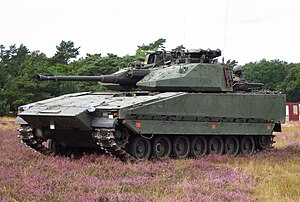| Combat Vehicle 90 | |
|---|---|
 A strf 9040C in Swedish service | |
| Type | Infantry fighting vehicle |
| Place of origin | Sweden |
| Service history | |
| In service | 1994–present |
| Used by | See Operators |
| Wars | |
| Production history | |
| Designer | Hägglunds/Bofors |
| Designed | late 1980s |
| Manufacturer | BAE Systems AB |
| Produced | 1993–present |
| No. built | 1,400[1] |
| Specifications | |
| Mass | 23–38 tonnes (Mk 0 to Mk IV) |
| Length | 6.8 m (22 ft)[2] |
| Width | 3.2 m (10 ft) |
| Height | 2.8 m (9 ft 2 in) |
| Crew |
|
| Armor | front against 30 mm APFSDS, all-round protection against 14.5 mm AP rounds, integration of Iron Fist APS |
Main armament |
|
Secondary armament |
|
| Transmission | Automatic Perkins X300 |
| Suspension | torsion bar or active suspension |
Operational range | offroad 320 km (200 mi), onroad 900 km (560 mi) |
| Maximum speed | 70 km/h (43 mph) |
The Combat Vehicle 90 (CV90) (Swedish: stridsfordon 90, strf 90 or Stridsfordon 90) is a family of Swedish tracked armoured combat vehicles designed by the Swedish Defence Materiel Administration (FMV), Hägglund & Söner and Bofors during the mid-1980s to early 1990s, before entering service in Sweden in the mid-1990s. The CV90 platform design has continuously evolved from the Mk 0 to the current Mk IV with technological advances and changing battlefield requirements.[3]
The Swedish version of the main infantry fighting vehicle (IFV) is fitted with a turret from Bofors equipped with a 40 mm Bofors autocannon. Export versions are fitted with Hägglunds E-series turrets, armed with either a 30 mm Mk44 or a 35 mm Bushmaster autocannon. Over time, the involvement of Hägglund & Söner has been superseded by Alvis Hägglunds (from 1997) and BAE Systems Hägglunds (from 2004).[3]
Developed specifically for the Nordic subarctic climate, the vehicle has very good mobility in snow and wetlands while carrying and supporting eight, and in later versions six, fully equipped soldiers. Other variants include forward artillery observation, command and control, anti-aircraft, armoured recovery vehicle, electronic warfare versions and so forth. Currently, 1,400 vehicles in 17 variants are (or will be) in service with ten user states, seven of which are part of the NATO alliance.[4]
- ^ "Czech Republic awards BAE Systems $2.2 billion contract to acquire 246 CV90s". BAe systems. Archived from the original on 16 June 2023. Retrieved 16 June 2023.
- ^ "Official CV90 MkIV specs". CV90. CZ. Archived from the original on 21 August 2023. Retrieved 15 June 2023.
- ^ a b "CV90 Armoured Combat Vehicle". Army Technology. Archived from the original on 31 October 2018.
- ^ "Czech Republic awards BAE Systems $2.2 billion contract to acquire 246 CV90s". 24 May 2023. Archived from the original on 24 May 2023.